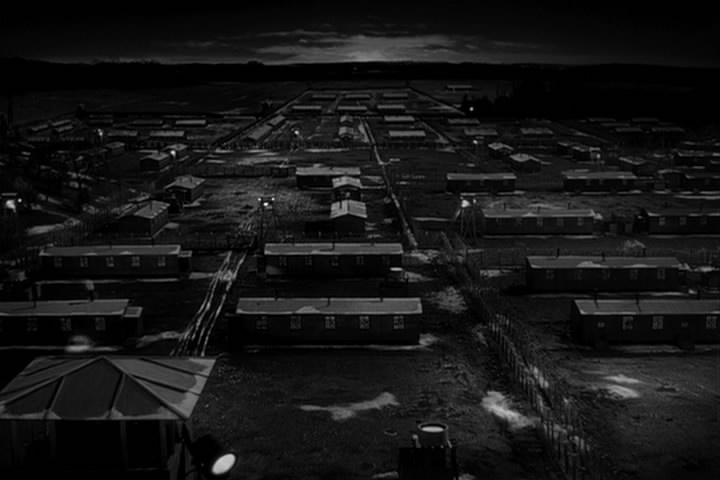
STALAG 17—–unless you look at War as the ultimate human farce (in a bulging array), making a comedy set in one can be a tricky maneuver, requiring the skills of a general and the right troops. Setting one in a prison camp—a Nazi prison camp—ups the ante. Shooting combat and/or confinement craps in a serio-comic vein, blending laughs with mayhem, takes an even more deft touch. This 1953 tale works on the dramatic end, thanks to a few good actors, fine production design and director Billy Wilder’s way with sculpting performances. It loses the battle in the joke department thanks to writer Wilder’s tendency to go a gag too far and too loud, rubbing your face in it, and in some of the less-controlled hamming from a few cast members.

1944, somewhere on the Danube. American airmen, captives of the Reich, suspect that there may be an informer in their barracks, letting the Germans know when to stop escapes and prevent communication from outside. Suspicion turns on blithely cynical ‘Sefton’ (William Holden, winning an Oscar), who not only scorns breakout attempts but runs several barter schemes that bring him better food and even manages dalliance with the female Russian prisoners in the next compound.
I recall thinking the clowning of supporting actors Robert Strauss, Harvey Lembeck and Sig Ruman was funny as a child, but seen today it grates, quickly, the overplaying nearly grotesque. I appreciate the idea of men desiring women as much as any guy who does so but making jokes at the expense of Russian female captives—once more, of the Nazis—rakes comedy into coal. At the least, that stuff here just isn’t funny. Wilder co-wrote with Edwin Blum, from a successful play: everyone is so unpleasant that by the time it gets to the end of its two-hour stay, the only thing you look forward to is seeing the informant get killed.*

The dramatic angle works much better. Filmed in the winter near Woodland Hills, California, the seasonal rain made for an atmospheric sea of mud to enhance the realistic appearance of the camp, and Ernest Laszlo’s b&w lensing is starkly effective. While broad clowning from the above trio wears thin in a jiffy, three more of the supporting players do very well: Otto Preminger as the casually sadistic commandant (a renowned bully, Herr Otto nailed his Nazi), tough Neville Brand as Sefton’s chief accuser, and Peter Graves (coming up at 26) as someone too slick for mercy (he later called this “the greatest role of my life”). The movie works in its best groove thanks to Holden, who manages to remain charming while being abrasive. As usual, he’s quite good, though I’d agree with his own appraisal and award his Oscar elsewhere. Wilder was nominated for Director, Strauss for Supporting Actor. **
Produced for $1,661,530, it earned $10,000,000, 17th place that year. With Richard Erdman, Don Taylor, William Pierson, Gil Stratton, Jay Lawrence (kid brother of Larry Storch) and Ross Bagdasarian (aka David Seville of “The Chipmunks Song”).

* The play, directed on Broadway by Jose Ferrer, ran 472 performances, giving John Ericson a big break as Sefton (he never really took off in films, transferring mostly to TV work). Strauss & Lembeck recreated their roles from the play. Written by Donald Bevan and Edmund Trzcinski, it was based on their own WW2 confinement at the real Stalag 17B, in Krems, Austria. Bevan, a POW for two years, was one of Sardi’s caricaturists, drawing famous diners for 20 years. Trzcinski has a brief bit (“I believe it!“) in the film. He was so offended by Wilder’s changes to the play that he quit speaking to him. Co-scenarist Blum also felt slighted and belittled by the director. Along with writing for movies, Blum wrote jokes and speeches for Adlai Stevenson and Hubert Humphrey, and may have originated Nixon’s nickname ‘Tricky Dick’, which was first used in a speech Blum wrote for Helen Gahagan Douglas. On a more collegiate note, the charming Holden remained the acerbic Wilder’s favorite leading man: they worked together in Sunset Boulevard, Sabrina and Fedora.

** Achtung!, long-winded Oscar-winners! Holden’s speech: “Thank you.” He felt the award should have gone to either Burt Lancaster or Montgomery Clift for their superior work in The Big war film of the year, From Here To Eternity, and he’s right. Much as we like him, better work that year was also proferred by the un-nominated Alan Ladd as Shane and Charles Winninger in the little-seen The Sun Shines Bright. Holden was better in The Bridge On The River Kwai, The Wild Bunch, Breezy, Network, the unsung The Wild Rovers, as well as in a great romantic flick critics dismiss, The World Of Suzie Wong.

Say what you will, we love this movie. The spy features were properly low tech, and ingenious at the same time. The comic relief didn’t hold up for you, sorry about that.